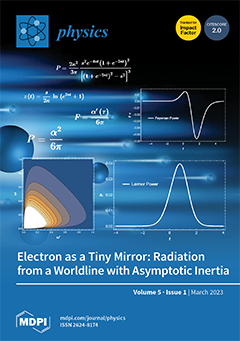In this paper, a series of numerical simulations is performed to recreate small-scale two-fluid jets using the JOANNA code, considering the magnetohydrodynamics of two fluids (ions plus electrons and neutral particles). First, the jets are excited in a uniform magnetic field by using
[...] Read more.
In this paper, a series of numerical simulations is performed to recreate small-scale two-fluid jets using the JOANNA code, considering the magnetohydrodynamics of two fluids (ions plus electrons and neutral particles). First, the jets are excited in a uniform magnetic field by using velocity pulse perturbations located at
1.3, 1.5, and 1.8 Mm, considering the base of the photosphere at
. Then, the excitation of the jets is repeated in a magnetic field that mimics a flux tube. Mainly, the jets excited at the upper chromosphere (
Mm) reach lower heights than those excited at the lower chromosphere (
Mm); this is due to the higher initial vertical location because of the lesser amount of plasma dragging. In both scenarios, the dynamics of the neutral particles and ions show similar behavior, however, one can still identify some differences in the velocity drift, which in the simulations here is of the order of
km/s at the tips of the jets once they reached their maximum heights. In addition, the heat due to the friction between ions and neutrals (
) is estimated to be of the order of 0.002–0.06 W/m
. However, it hardly contributes to the heating of the surroundings of the solar corona. The jets in the two magnetic environments do not show substantial differences other than a slight variation in the maximum heights reached, particularly in the uniform magnetic field scenario. Finally, the maximum heights reached by the three different jets are found in the range of some morphological parameters corresponding to macrospicules, Type I spicules, and Type II spicules.
Full article





